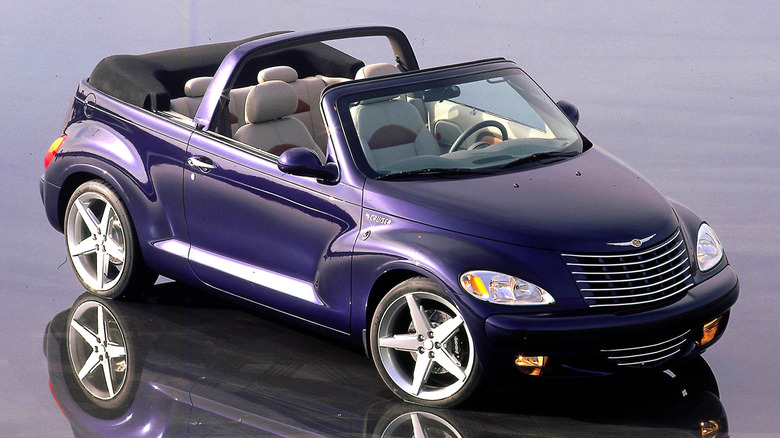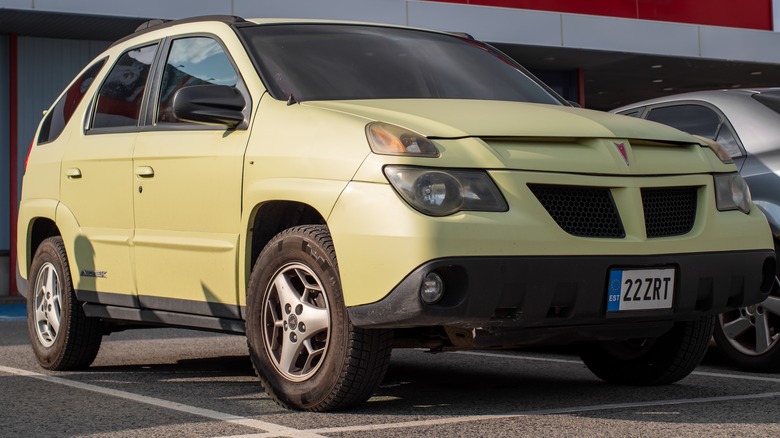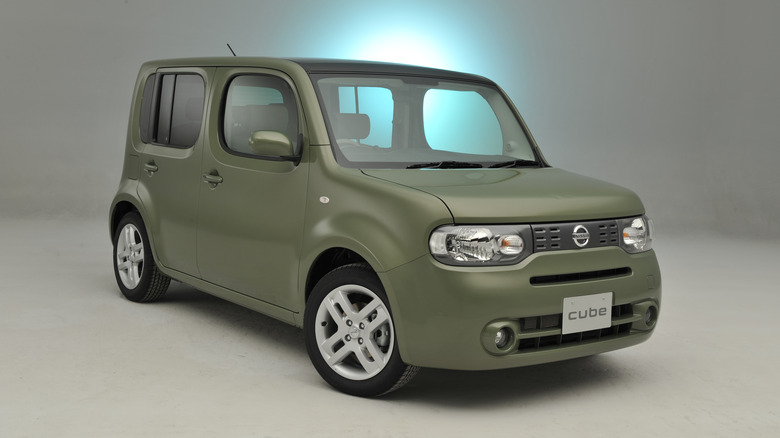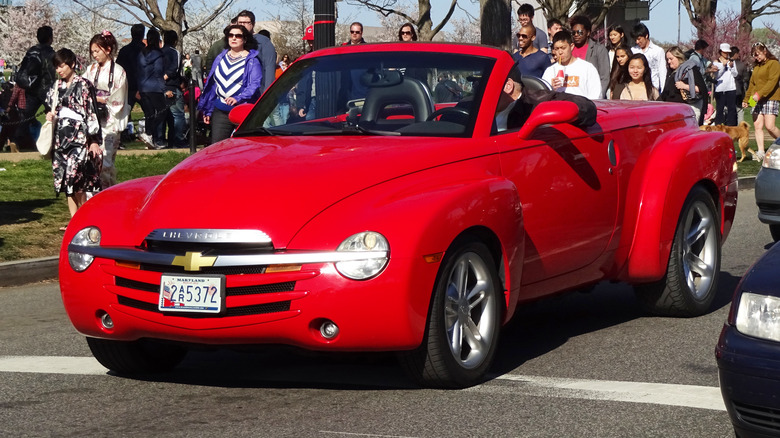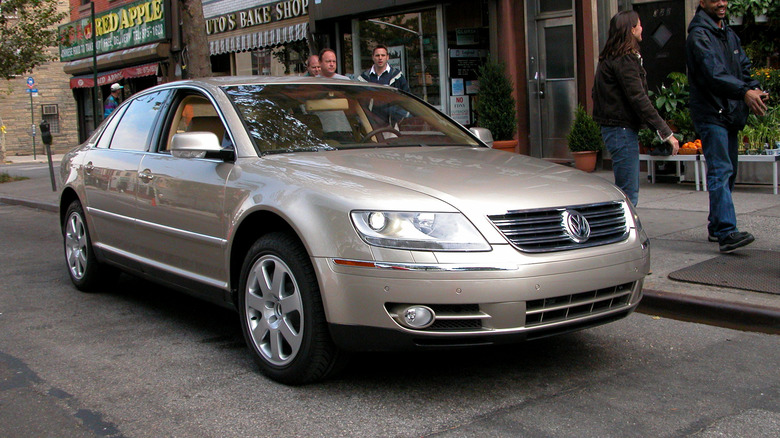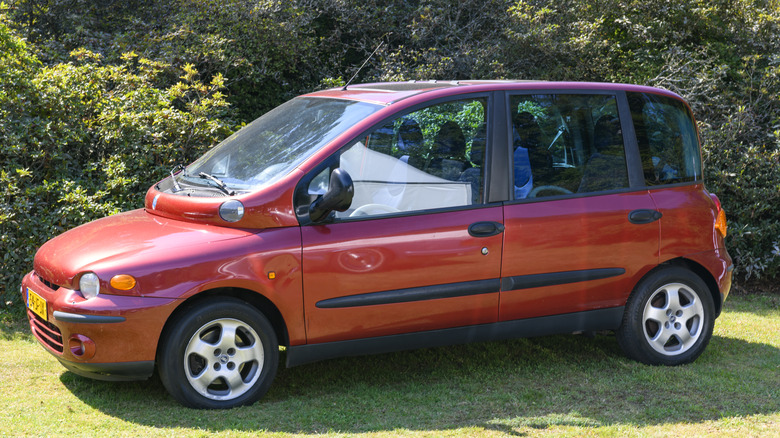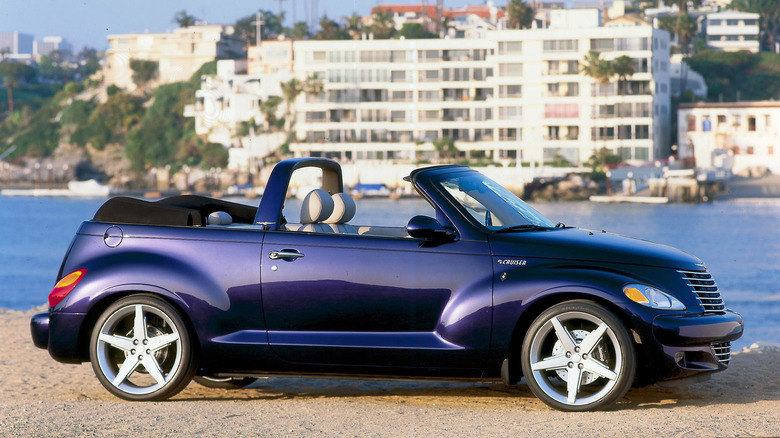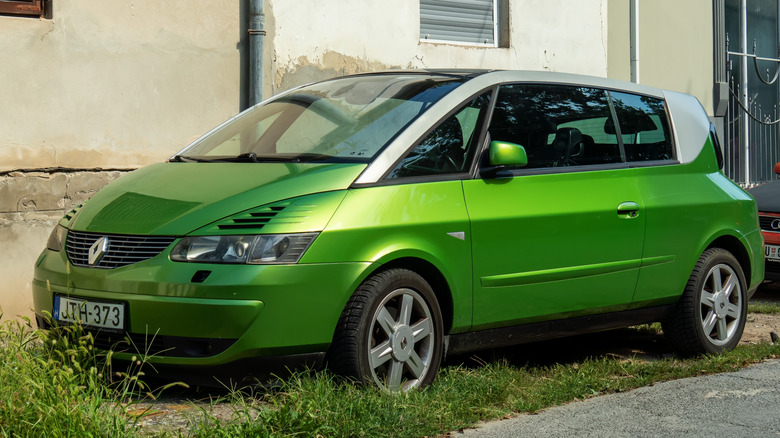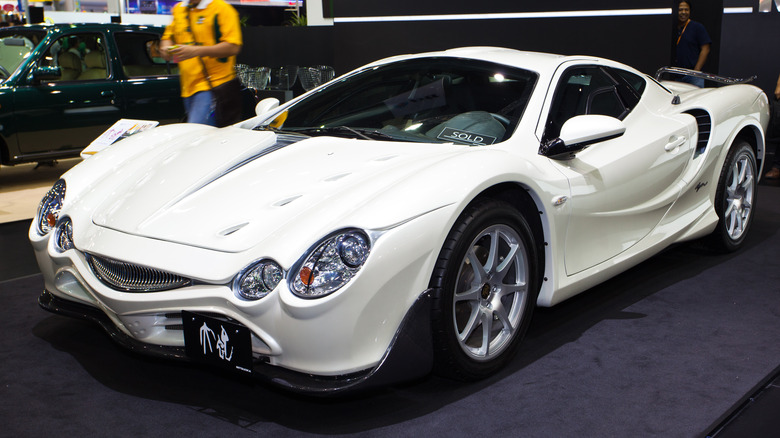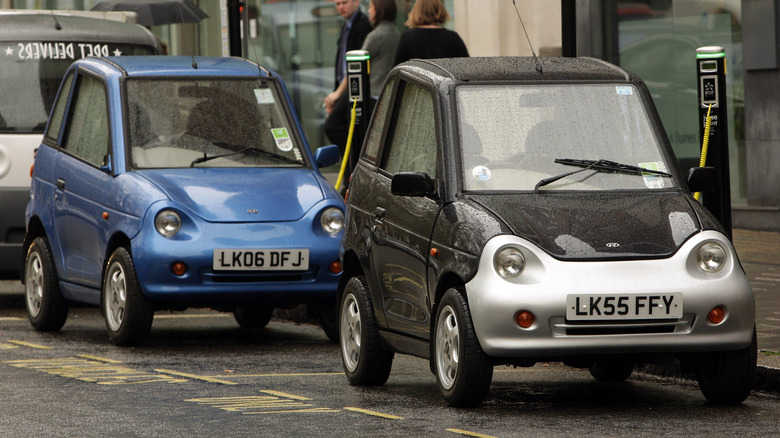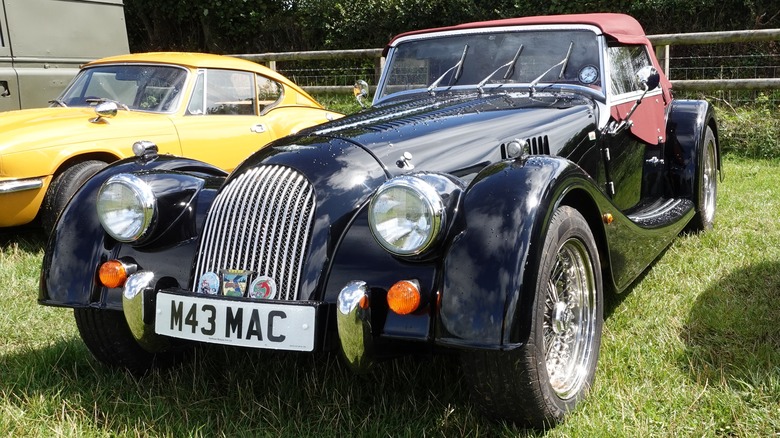10 Of The Strangest Cars Made In The 2000s
The crossovers and SUVs that dominate the market today are often accused of looking the same, with very little to distinguish between brands. However, back in the 2000s, the word crossover was applied to a very different set of cars. Manufacturers were still experimenting with combining all sorts of body styles, with the resulting cars sometimes being sales hits while others ended up being major flops. This era of experimentation birthed cars that were different from anything before them, sometimes for better and sometimes for worse.
These strange creations could be found across a wide variety of market segments, too. From convertible pickups to sports cars with dragon nostrils, buyers looking for something unique were spoilt for choice. We've rounded up a selection of ten of the strangest cars from the era, some of which flopped because of their unique features or divisive styling and some of which became surprise commercial hits.
Pontiac Aztek
The Aztek is arguably one of the most famous weird cars of all, turning heads when it launched in the early 2000s and later being immortalized as Walter White's car in "Breaking Bad." It's widely regarded as a failure for Pontiac and helped send the already-struggling marque to its grave just a few years later. It only takes one look at the Aztek to realize what's so strange about it — this is a mechanically unremarkable crossover that features some of the most divisive styling ever to come out of GM's studios.
The longer you look, the stranger it gets, from the split front headlight and grille design to the prominent plastic paneling present across the car. On paper, the Aztek seemed competitive, perhaps even appealing, with a tried-and-tested V6 engine making a healthy 185 horsepower. It was reasonably well equipped for a GM car of the era, too, but none of that really mattered too much when the car itself was quite such an eyesore. Its looks and role in helping seal the fate of Pontiac as a brand even earned it a spot on our list of the worst cars ever made.
Nissan Cube
Unlike the Pontiac Aztek, the Nissan Cube has just as many staunch defenders as it does critics, but whatever you think of the car, it's undeniably strange. One of its most unique features is the side-opening rear door, which was reportedly inspired by old-school refrigerators. According to a Nissan press release, the designers of the car thought it looked like a "bulldog in sunglasses" and customers were encouraged to personalize their car with Nissan's range of "accessories and tattoos."
The Cube launched in America in 2009 but had been sold in Japan for around ten years prior and had already built up a cult following there. Using cubic design has proven to be an effective way to generate the most interior space without increasing overall footprint -– just look at Japan's kei cars -– but the design didn't catch on with foreign automakers. That's kept the Cube an extremely distinctive car, and one that's sure to attract attention, even more than a decade after its U.S. debut.
Chevrolet SSR
Sometimes, creating mashups of existing car body styles can create a winning formula, such as with the success of the modern crossover SUV. In other cases, however, you end up with something as strange as the Chevrolet SSR, a retro-styled pickup truck with a convertible roof and a powerful V8 under the hood. Despite generating plenty of hype when it was unveiled, it never sold well, and eventually Chevy even shut the factory where it was produced.
There have been plenty of theories put forward as to why the SSR flopped, but perhaps the most likely is that it simply wasn't very good at doing all the things it promised buyers. It wasn't that practical as a pickup, with its underwhelming towing capacity and a smaller-than-average bed. It also wasn't as refined as rival convertibles from conventional luxury brands, and although its V8 was powerful, the SSR wasn't as quick as dedicated street trucks like the Dodge Ram SRT-10.
However, it was almost as expensive –- the SSR cost roughly $42,000, while the Ram cost just over $45,000. A series of upgrades over its life improved its power output and made other tweaks, but those changes never enticed enough buyers. Its failure means that, for better or for worse, GM is not likely to make anything quite like it again.
VW Phaeton W12
At the turn of the century, VW was reinventing itself by unveiling a W12-powered supercar in 1997 that it continued to revisit into the early '00s, although it never got the production green light. However, that wasn't the only way bosses were planning to take the VW brand upmarket. They were also developing a VW-badged luxury limo, which would share the same platform and — in top-spec form — engine as the Bentley Continental. This unlikely creation did make it to production and was christened the VW Phaeton.
The Phaeton was a very odd car that never really found its target market. It was, at first glance, very similar looking to the run-of-the-mill VW Passat, a European family favorite sedan and just about the polar opposite of what most buyers considered luxurious or exclusive. However, it featured a mashup of components pulled from the VW, Audi, and Bentley parts bins but didn't always seem to use the right parts in the appropriate place. The cabin, for example, featured switchgear and materials shared with VW Group's much lower-end models, while the W12 engine was unnecessarily complicated to repair for a VW.
Ultimately, the Phaeton never made much sense as a luxury car, especially since it cost around $100,000, roughly the same as a well-equipped Mercedes-Benz S-Class. In the U.S., it was only sold between 2004 and 2006, but in Europe, it hung on until 2016.
Fiat Multipla
Produced by Fiat for the European and Chinese markets, the Multipla was a family minivan with a twist. It could seat six, with three seats in the front row and three in the second row, making it considerably wider yet much shorter than most family haulers. To accommodate its tall, upright cabin, designers took the unusual step of creating a two-tier design, giving it the appearance of two separate cars that had been fused together. Even the headlights were separate, with a pair fitted to the bulge that joined the windshield to the more conventional hood.
Despite its strange looks, it was generally considered by reviewers to be a good car, winning awards from the likes of "Top Gear" upon its release. It handled well considering its unusual shape, it was reasonably priced, and most importantly, it was very practical for larger families. However, a lot of buyers simply couldn't get past its looks, leaving it languishing behind its rivals in sales charts and making it a costly mistake for Fiat. A second generation Multipla was launched in the mid-'00s that somewhat fixed the car's unconventional styling, but it still struggled to sell, and by 2011, it was axed altogether.
Chrysler PT Cruiser Convertible
Another famously weird car produced throughout the '00s was the Chrysler PT Cruiser. Its retro looks made it a surprise hit during the first half of the decade, although sales sharply tailed off during the second half. Like many Chrysler products at the time, the PT Cruiser wasn't particularly well built, and so its styling charms were the main reason buyers flocked to the car — or they were the reason buyers stayed well away from it.
The PT Cruiser was originally designed as a kind of shrunk-down, retro-themed minivan, with four doors and just about enough room to fit a family. However, the two-door convertible version cranked the strangeness up a notch. Here the car lost any semblance of practicality, with the tradeoff of some added retro appeal.
As its name implies, this was an open-top cruiser, built for personal enjoyment above practicality, and indeed there are plenty of enthusiasts today that continue to be won over by its charms. Newcomers wanting to join the car's large fan club are in luck too, as its divisive styling and mediocre build quality has kept used prices very low.
Renault Avantime
Chrysler wasn't the only company to venture into making two-door minivans during the early '00s. Renault was also doing just that, and its short lived minivan-coupe crossover was called the Avantime. Sold only in Europe, the Avantime was certainly a step above the average family hauler in the styling department, although this came at the cost of sacrificing some practicality.
It could only seat four people, which was particularly strange given that the car it was based on, the more traditionally styled Espace minivan, could seat seven. Luggage space was also reasonable for the segment, although carrying larger loads would require the seats to be folded down, reducing the seating to just two. So, this was a car for people who wanted minivan styling but without the practicality that a regular minivan offered. Needless to say, there wasn't much of a market for such a strange vehicle, and the Avantime sold poorly throughout the two years it was on sale.
Mitsuoka Orochi
One of Japan's smallest and oddest carmakers, Mitsuoka is best known for its weird-looking conversions of popular cars. However, it has also penned a small number of in-house models, including the Orochi supercar. Well, supercar is really the wrong term –- it looks the part, but with its 233 horsepower Toyota V6, it's severely lacking in the performance department.
The car was originally built using the same platform as the Acura NSX, but Honda axed the NSX just as Mitsuoka was gearing up to begin production. However, instead of writing the project off, the company decided to build its own chassis instead, as well as source a new engine. As a result, it used a mix of Honda and Toyota components but fabricated its distinctive bodyshell in-house.
The Orochi's design was inspired by a dragon from Japanese folklore, complete with headlights that look like beady eyes and vents in the hood representing nostrils. It's undoubtedly one of the weirdest-looking cars of its era and became a cult hit in Japan because of it. Over the years, that has led Japan's infamously mad tuning houses to produce their own versions, with Liberty Walk's widebody Orochi being a particularly memorable reinterpretation of the car's styling.
Reva G-Wiz
Little more than a glorified mobility scooter with a license plate, the G-Wiz was essentially a rolling death trap. It was sold in the UK and various other markets around the world and gained infamy as the regular butt of jokes on "Top Gear." It was one of the earliest electric vehicles available in the UK, but was extremely impractical, with an officially claimed (and reportedly very optimistic) range of 50 miles. The car also topped out at around 50 mph, although it could become unstable at half that speed.
The car's official classification as a quadricycle meant that it was exempt from meeting crash test regulations, but "Top Gear" bought one and tested it independently. The results were damning: even at everyday speeds of 30 mph, a collision would almost certainly cause severe injuries (or worse) to both the driver and passenger. It was both a dangerous car to drive on the road and, thanks to its compact proportions, a very strange looking one. Thankfully, it was discontinued in 2011.
Morgan Roadster
Despite its classic looks, the Morgan Roadster was a new model for 2004. It replaced the Plus 8, with the main upgrades being a new Ford V6 engine making 223 horsepower. Most of the rest of the car was left unchanged, including the frame, which was made of ash wood. Morgan has for years represented an odd corner of the auto industry, making cars that look like they're frozen in time, despite boasting modern internals underneath. The company continues to make cars the same way today, but in the '00s, it was the Roadster that was the marque's freshest new-old model.
While its handling tallied with its old-school looks, it was quicker in a straight line than many bystanders would assume. A 0-60 mph time of 4.9 seconds would comfortably beat a stock Mustang GT from the same year off the line, even if the Morgan Roadster's top speed of 134 mph was no match for the pony car.
A thoroughly strange car, then, but one with a sizable and enthusiastic fanbase that continues to keep the company's waitlist a healthy six to 12 months long today.
